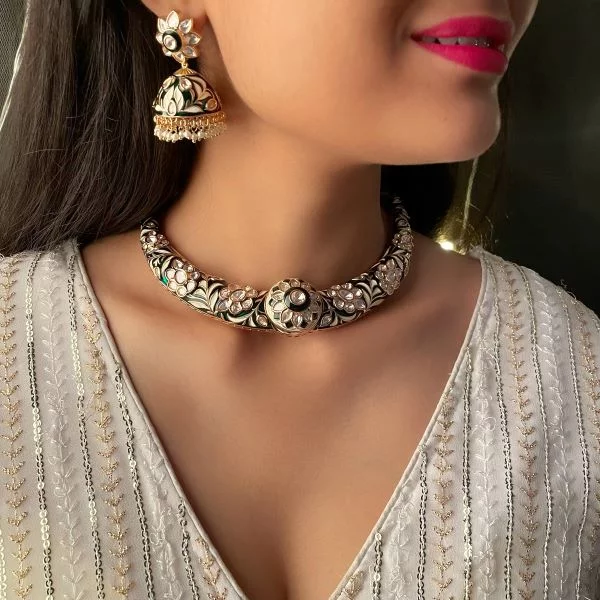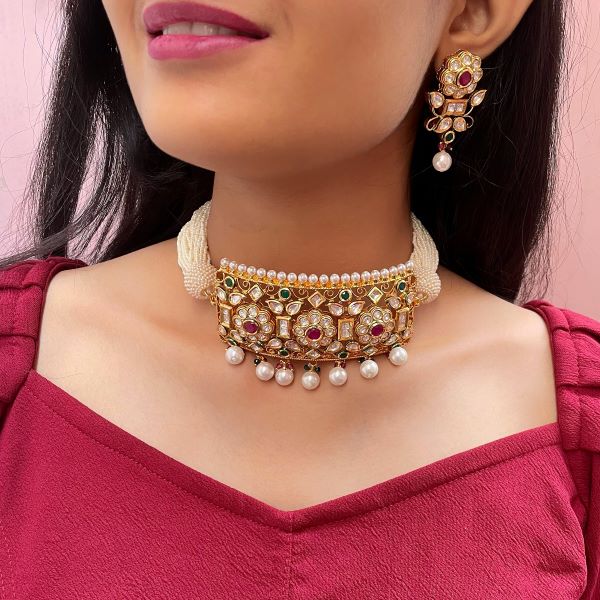Jewelry Buying Guides, Styling Guides
The Art of Polki and Kundan Indian Jewelry
Indian jewelry is renowned for its intricate designs and timeless beauty, with Kundan and Polki styles being one of the most exquisite examples. These forms of artificial jewelry have been cherished for centuries, symbolizing the rich cultural heritage and unparalleled craftsmanship of Indian artisans. The process of making Kundan and Polki jewelry is a meticulous art, showcasing the dedication and skill required to create these stunning pieces.
The Origins and Significance of Kundan and Polki Indian Jewelry
Kundan and Polki jewelry traces its origins back to the Mughal era, known for its grandeur and splendor. “Kundan” means highly refined gold, while “polki” means uncut, natural diamonds. Both styles are an integral part of traditional Indian jewelry, often worn on weddings, festivals and other important occasions. The charm of Kundan and Polki jewelry lies in their ability to blend traditional aesthetics with intricate craftsmanship, making them precious heirlooms passed down through generations.
Click here to buy
Devishi Emerald Green Polki Husli Necklace Set
The Intricate Process of Making Kundan Indian Jewelry
Making Kundan jewelry is a labor-intensive process that requires precision and skill. The journey begins with the creation of the base, which is usually made of pure gold. Delicate designs are then engraved on the base, setting the stage for further intricate work.
The next step is the creation of Kundan, which refers to highly refined gold. This gold is beaten into strips and used to set gems on a base. The artisans carefully place each stone in the setting, ensuring they fit perfectly and stay securely in place. This process, known as Kundan setting, requires an extraordinary level of patience and expertise, as the slightest miscalculation can ruin the entire piece.
Once the stones are inlaid, the gaps are filled with lacquer, a natural resin, to provide additional support. The final step involves polishing the piece to a high gloss to enhance the shine of the stones and gold. The result is a stunning piece of Indian jewelry that exemplifies the art of Kundan.
The Unique Charm of Polki Indian Jewelry
Like Kundan, Polki jewelry is also known for its traditional charm and elegance. What sets Polki apart is that it uses uncut diamonds, which retain their natural, organic shape. These diamonds are not pointed like modern diamonds, giving Polki jewelry a distinct and raw charm.
The process of making Polki jewelry begins with the selection of diamonds, which are then set in gold or silver foil to enhance their sparkle. These diamonds are carefully arranged in intricate patterns, often complemented by other gemstones such as emeralds, rubies and sapphires.
Setting uncut diamonds requires great skill, as the natural shapes must fit seamlessly into the design. The artisans use a technique called jadau, in which the stones are set into the framework without using any adhesive. Instead, the stones are secured by wrapping gold foil around them. This traditional technique, passed down for generations, gives polki jewelry its unique character and durability.
A Timeless Appeal
Kundan and Polki Indian jewelry have stood the test of time and have retained their charm for centuries. Their timeless appeal lies in their ability to blend tradition and beauty, making them relevant in both historical and contemporary contexts. Today, these jewelry pieces are not only worn on special occasions like weddings and festivals but are also cherished as heirlooms passed down through generations.
Click here to buy
Shree Ruby Green Pearl Kundan Choker Set
Kundan and Polki Indian Jewelry is much more than mere adornment; they are a symbol of India’s rich cultural heritage and the unparalleled craftsmanship of its artisans. The intricate process of creating these pieces reflects the dedication and skill involved, ensuring that each piece is unique and timeless. Whether admired for their beauty or their historical significance, Kundan and Polki jewelry continue to enchant and inspire, keeping the art of Indian jewelry alive and thriving.




